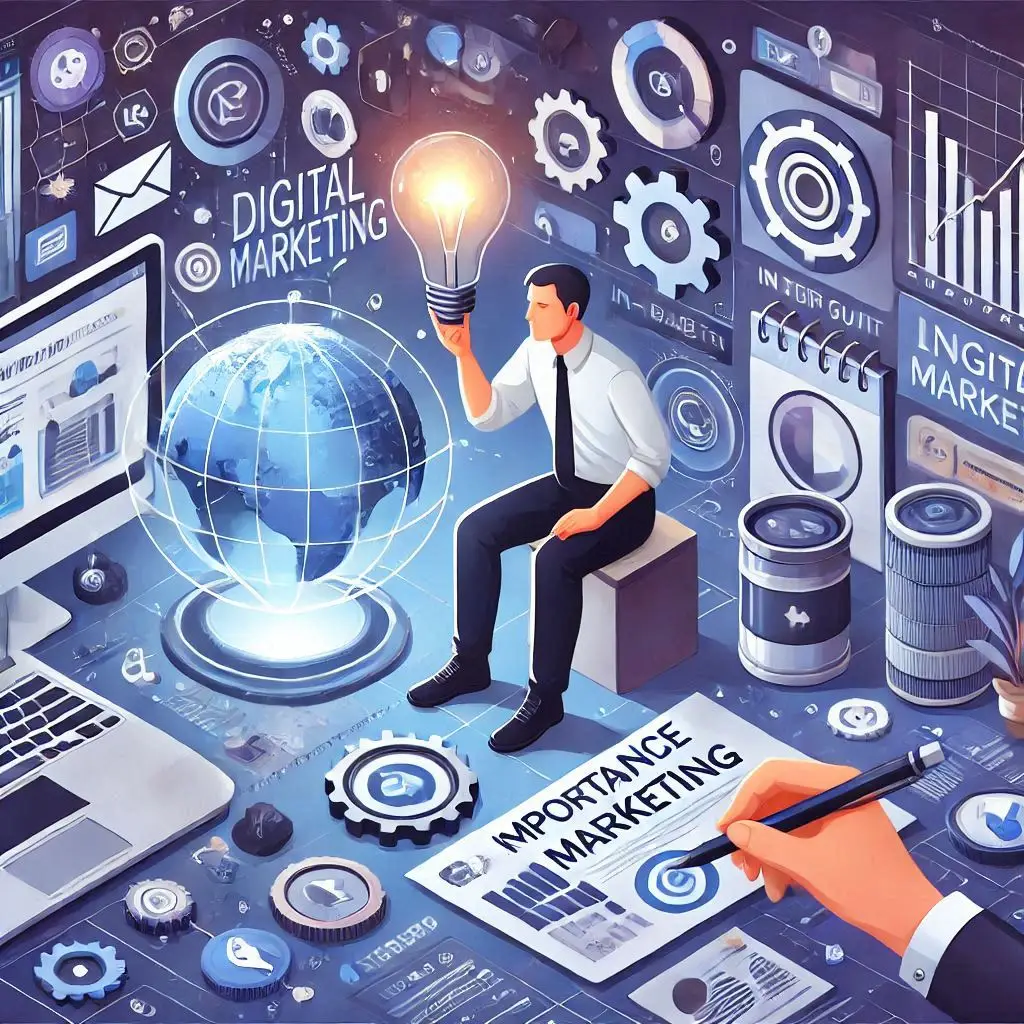In today’s fast-paced world, the internet has become a cornerstone of daily life. From shopping to learning, entertainment to business, almost everything has gone digital. For businesses, this shift means finding innovative ways to connect with their audience online. This is where digital marketing comes into play. But what exactly is digital marketing, and why is it so crucial? Let’s dive into the topic in simple terms.

Table of Contents
ToggleUnderstanding Digital Marketing
Digital marketing refers to the use of the Internet and electronic devices to promote products or services. It includes a variety of online marketing techniques, such as search engine optimization (SEO), social media marketing, email campaigns, and content marketing, all of which aim to reach a targeted audience.
In simple terms, digital marketing is just like traditional marketing. Still, instead of billboards, TV ads, or flyers, businesses use websites, social media platforms, search engines, and email to communicate with their customers.
Why is Digital Marketing Important?
- Global Reach: Unlike traditional methods, digital marketing allows businesses to reach audiences across the globe. A small local business can showcase its products to customers in different countries through a website or social media.
- Cost-Effectiveness: Traditional advertising, like TV or newspaper ads, can be expensive. Digital marketing offers affordable options, such as running social media ads or email campaigns, which can provide better returns on investment.
- Targeted Marketing: Digital platforms allow businesses to target specific demographics. For instance, you can create ads that are only shown to people of a certain age, gender, location, or interest, ensuring your message reaches the right audience.
- Measurable Results: With digital marketing tools, businesses can track how many people saw their ad, clicked on it, or made a purchase. This data helps refine strategies and improve performance.
- Engagement: Platforms like Instagram, Facebook, and Twitter allow direct interaction between businesses and their customers. Answering queries, responding to reviews, and engaging with your audience builds trust and loyalty.
Key Components of Digital Marketing
Digital marketing isn’t just one thing; it’s a mix of several strategies and channels. Here are the major components:
1. Search Engine Optimization (SEO):
SEO is the practice of optimizing your website so it ranks higher on search engines like Google. The higher your site appears, the more likely people will visit it. For example, if you run a bakery, you’d want your site to appear when someone searches for “best bakery near me.”
2. Content Marketing:
Content marketing involves creating and sharing valuable content to attract and retain an audience. This could include blog posts, videos, infographics, or eBooks that educate or entertain your audience while subtly promoting your brand.
3. Social Media Marketing:
Platforms like Facebook, Instagram, LinkedIn, and Twitter are powerful tools for connecting with your audience. By sharing posts, running ads, and engaging with followers, businesses can increase brand awareness and drive sales.
4. Email Marketing:
Email marketing involves sending tailored messages to your audience’s inbox. Whether it’s a promotional offer, a newsletter, or a product update, email remains one of the most effective ways to communicate directly with customers.
5. Pay-Per-Click Advertising (PPC):
PPC allows businesses to display ads on search engines or social media platforms. They pay only when someone clicks on the ad. Google Ads is a popular PPC platform.
6. Affiliate Marketing:
Affiliate marketing is a performance-based strategy where businesses reward affiliates (partners) for driving traffic or sales through their referrals.
7. Influencer Marketing:
Collaborating with influencers—people with a significant following on social media—can help businesses reach new audiences. Influencers promote your products to their followers, boosting visibility and credibility.
8. Video Marketing:
Videos are engaging and can communicate a lot in a short time. Platforms like YouTube, Instagram Reels, and TikTok are popular for sharing promotional videos, tutorials, or behind-the-scenes content.
How Does Digital Marketing Work?
The process of digital marketing typically involves the following steps:
- Understand Your Audience: Knowing your target audience is essential. What are their needs, preferences, and online behaviors? This information helps tailor your marketing efforts.
- Set Clear Goals: Whether you want to increase website traffic, generate leads, or boost sales, having clear objectives ensures a focused approach.
- Choose the Right Channels: Not every platform will suit your business. For instance, LinkedIn might be ideal for B2B marketing, while Instagram is better for visually appealing products.
- Create Engaging Content: Quality content is the backbone of digital marketing. It should be relevant, valuable, and aligned with your brand’s voice.
- Analyze and Optimize: Digital marketing isn’t a one-time effort. Use analytics tools to measure performance, identify what’s working, and adjust your strategy for better results.
Challenges in Digital Marketing
While digital marketing offers numerous benefits, it also comes with challenges:
- Constantly Changing Trends: Digital platforms frequently update their algorithms, making it necessary to stay up-to-date.
- High Competition: The internet is crowded with businesses vying for attention. Standing out requires creativity and a well-executed strategy.
- Managing Multiple Channels: Handling social media, email, SEO, and PPC campaigns simultaneously can be overwhelming without the right tools or team.
- Privacy Concerns: As privacy regulations like GDPR come into play, businesses must handle user data responsibly and transparently.
The Future of Digital Marketing
The digital marketing landscape is ever-evolving. Here are some trends shaping its future:
- Artificial Intelligence (AI): AI is transforming how businesses analyze data, personalize experiences, and automate tasks like chatbots or content creation.
- Voice Search: With the rise of smart speakers like Alexa and Google Home, optimizing for voice search is becoming essential.
- Interactive Content: Quizzes, polls, and interactive videos are gaining popularity as they engage audiences more effectively.
- Sustainability: Consumers increasingly prefer brands that demonstrate social and environmental responsibility. Digital campaigns emphasizing sustainability are on the rise.
Conclusion
Digital marketing is a dynamic and essential tool for modern businesses. It’s not just about selling products or services; it’s about building relationships, understanding your audience, and creating meaningful connections. By leveraging the right strategies and staying updated with trends, businesses can thrive in the digital era. Whether you’re a small startup or a large corporation, embracing digital marketing is no longer an option—it’s a necessity.

